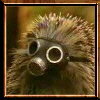darthlucy wrote:I can't remember the last time I laughed so hard! Starving wolverine?!?
Yeah, I loved that piece!
Jhon 32, you give me wayyyy too much credit, but thanks.
Since your doctor has you using an autopap set 12 - 18 , I don't think you need to be looking for a different machine yet. If I were you I'd try a Full Face mask. Won't matter if you breathe through your mouth or leak air out your mouth when wearing a FF mask. But as for which mask... your guess is as good as mine.
I turned to tape because that let me wear nasal pillows masks. Otherwise I'd have had to keep wearing a FF mask.
But here's something interesting that just happened in the last couple of months... I had tried chin straps in the past. They did nothing to stop the mouth breathing I do in my sleep. So, I've been taping for over three years. Occasionally I'd try going without tape, but each time I looked at the leak rate on my data it showed crazy massive leaks.
I had resigned myself to the idea that I'd be buying tape for the rest of my life. No big deal. I was used to it and really didn't mind using tape.
Then a fellow "tape-er" -- blarg -- told me he'd been able to get a chin strap to work finally, and had been able to give up taping. I was doubtful it would work for me...hadn't in the past. But I gave it a try again, this time using (what else!! LOL ) a pantyhose leg.
Maybe it's from the years of taped lips causing the tongue to become accustomed to being in a "sealed" position, or maybe it's because I pulled the homemade strap wide enough at the under-chin area to give upward support directly under my lower lip, keeping the lower lip pushed upward....but for whatever the reason, this time the chin strap has been getting the job done.
I've been able to use the homemade chin strap and no tape for two months now, and have been getting a very low, very steady leak rate on my overnight data. A leak rate every bit as consistently low as back when I used tape.
So, there are all kinds of ways to go about controlling mouth air leaks. Even some old ways that perhaps didn't work well at first are worth re-visiting from time to time.
I don't think the type of machine makes much difference when it comes to controlling mouth air leaks. The placement of the tongue is the whole key to creating an airtight seal inside the mouth.
While you work out whatever method gets that done for you, it's always a good idea to have a FF mask in the stash. If for nothing more than to have something that will allow you to mouth breathe and still get treatment on a night when congestion (a cold or bad allergies) make you nose too stuffy to get air through at all.
The only reason I'm using the BiPAP Auto is for comfortable exhaling. Now that the Auto with A-Flex is out, that machine sounds like it's just as comfortable. But I don't think either would have much effect on whether a person is going to leak air out the mouth.
I've been a big-time mouth air leaker on any kind of machine I've ever used, including the BiPAP Auto. Until now. And it still does take the homemade chin strap to keep not only my jaw, but also my lower lip up enough to let my tongue stay in a sealing position inside my mouth. Keeping the lower lip up apparently prevents little air puffs from escaping -- which used to turn into gushes of air out the mouth.
Good luck, John.
















